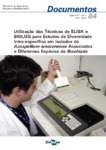Por favor, use este identificador para citar o enlazar este ítem:
http://www.infoteca.cnptia.embrapa.br/infoteca/handle/doc/568168Registro completo de metadatos
| Campo DC | Valor | Lengua/Idioma |
|---|---|---|
| dc.contributor.author | REIS JUNIOR, F. B. dos | pt_BR |
| dc.contributor.author | TEIXEIRA, K. R. dos S. | pt_BR |
| dc.contributor.author | REIS, V. M. | pt_BR |
| dc.date.accessioned | 2011-07-08T11:44:54Z | - |
| dc.date.available | 2011-07-08T11:44:54Z | - |
| dc.date.created | 2005-01-19 | pt_BR |
| dc.date.issued | 2003 | pt_BR |
| dc.identifier.citation | Planaltina, DF: Embrapa Cerrados, 2003. | pt_BR |
| dc.identifier.uri | http://www.infoteca.cnptia.embrapa.br/infoteca/handle/doc/568168 | pt_BR |
| dc.description | ABSTRACT: This limitation of nitrogen is considered one of the most important factors influencing the Brazilian pastures degradation. However there are evidences that pastures formed by some species of the Brachiaria genus could be benefited by the biological fixation (BNF), guaranteeing a higher longevity to these pastures. Previous studies showed that the diazotrophic bacteria found in association with these forage grasses were mainly from the Azospirillum amazonense species. Since associations between these microorganisms and plants are generally conditioned by the vegetation, it is possible that different Brachiaria genotypes can exercise a selective effect on the Azospirillum populations. The aim of this work was to study the intra-specific diversity of A. amazonense isolates and to establish possible influences of different Brachiaria species and edaphoclimatic conditions. The characterisation of the diversity among these isolates was conducted using serological tests (ELISA- Enzyme Linked Immunosorbent Assay) and tests of carbon sources metabolisation (BIOLOG). These methods were capable to show important information regarding the diversity among the studies isolates of A. amazonense. | pt_BR |
| dc.language.iso | por | pt_BR |
| dc.relation.ispartofseries | (Embrapa Cerrados. Documentos, 84). | pt_BR |
| dc.rights | openAccess | pt_BR |
| dc.subject | Feed grasses | pt_BR |
| dc.title | Utilização das técnicas de ELISA e BIOLOG para estudos de diversidade intra-específica em isolados de Azospirillum amazonense associados a diferentes espécies de brachiaria. | pt_BR |
| dc.type | Folhetos | pt_BR |
| dc.date.updated | 2011-07-08T11:44:54Z | pt_BR |
| dc.subject.thesagro | Bactéria | pt_BR |
| dc.subject.thesagro | Capim Brachiaria | pt_BR |
| dc.subject.thesagro | Fixação de Nitrogênio | pt_BR |
| dc.subject.thesagro | Gramínea Forrageira | pt_BR |
| dc.subject.thesagro | Microbiologia do Solo | pt_BR |
| dc.subject.nalthesaurus | Azospirillum amazonense | pt_BR |
| dc.subject.nalthesaurus | microbiology | pt_BR |
| dc.subject.nalthesaurus | nitrogen fixation | pt_BR |
| dc.subject.nalthesaurus | soil | pt_BR |
| dc.format.extent2 | 34 p. | pt_BR |
| riaa.ainfo.id | 568168 | pt_BR |
| riaa.ainfo.lastupdate | 2009-10-28 | pt_BR |
| Aparece en las colecciones: | Série Documentos (CPAC)  | |
Ficheros en este ítem:
| Fichero | Descripción | Tamaño | Formato | |
|---|---|---|---|---|
| doc84.pdf | 789,93 kB | Adobe PDF |  Visualizar/Abrir |









